This post may contain affiliate links, which means I may receive a small commission should you decide to click that link and make a purchase. For more information please refer to the Terms & Conditions.
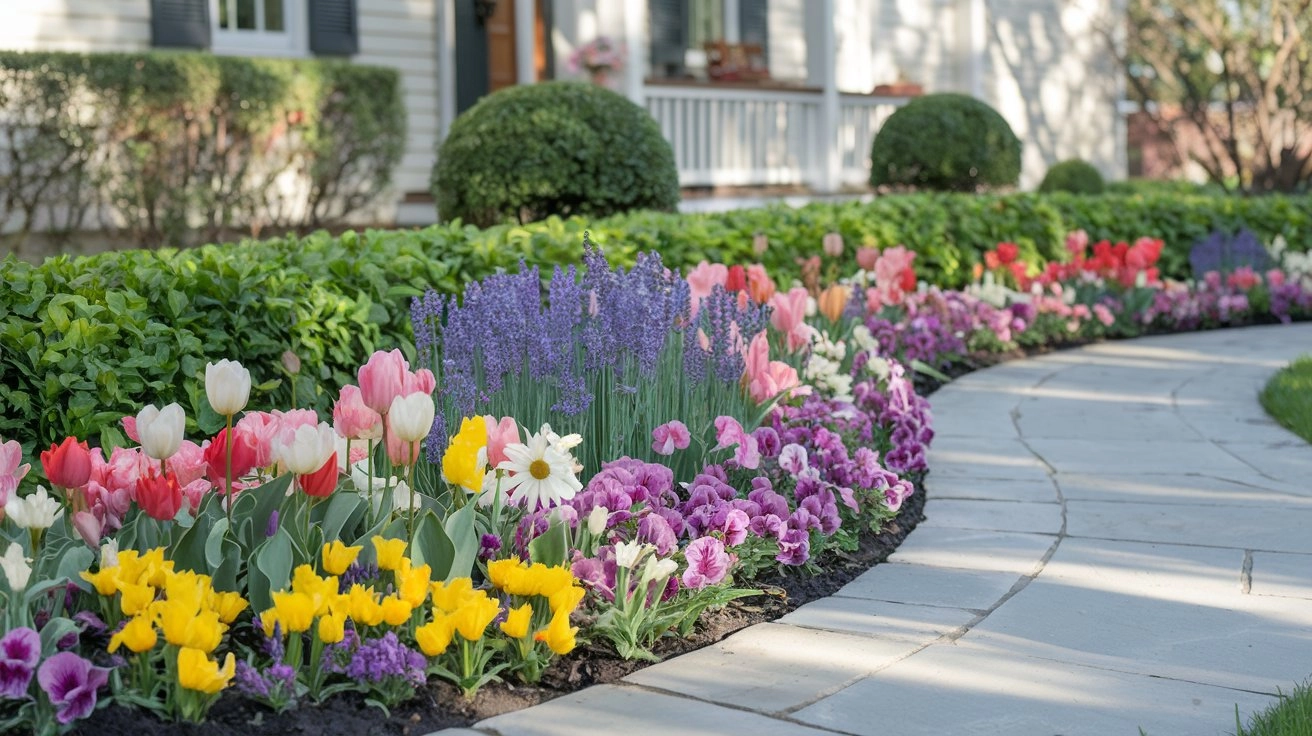
Easy Front Yard Flower Bed ideas can completely transform the look of your home’s entrance.
Welcome to my guide on creating stunning landscape features that make your home’s entrance pop!
I’m excited to share how well-planned gardens can change your property’s look.
The first impression visitors get is very important.
Last spring, I refreshed my front yard and was surprised by how a few wise planting choices made the whole space feel more polished and welcoming. The right mix of colors, textures, and heights can make any property look great.
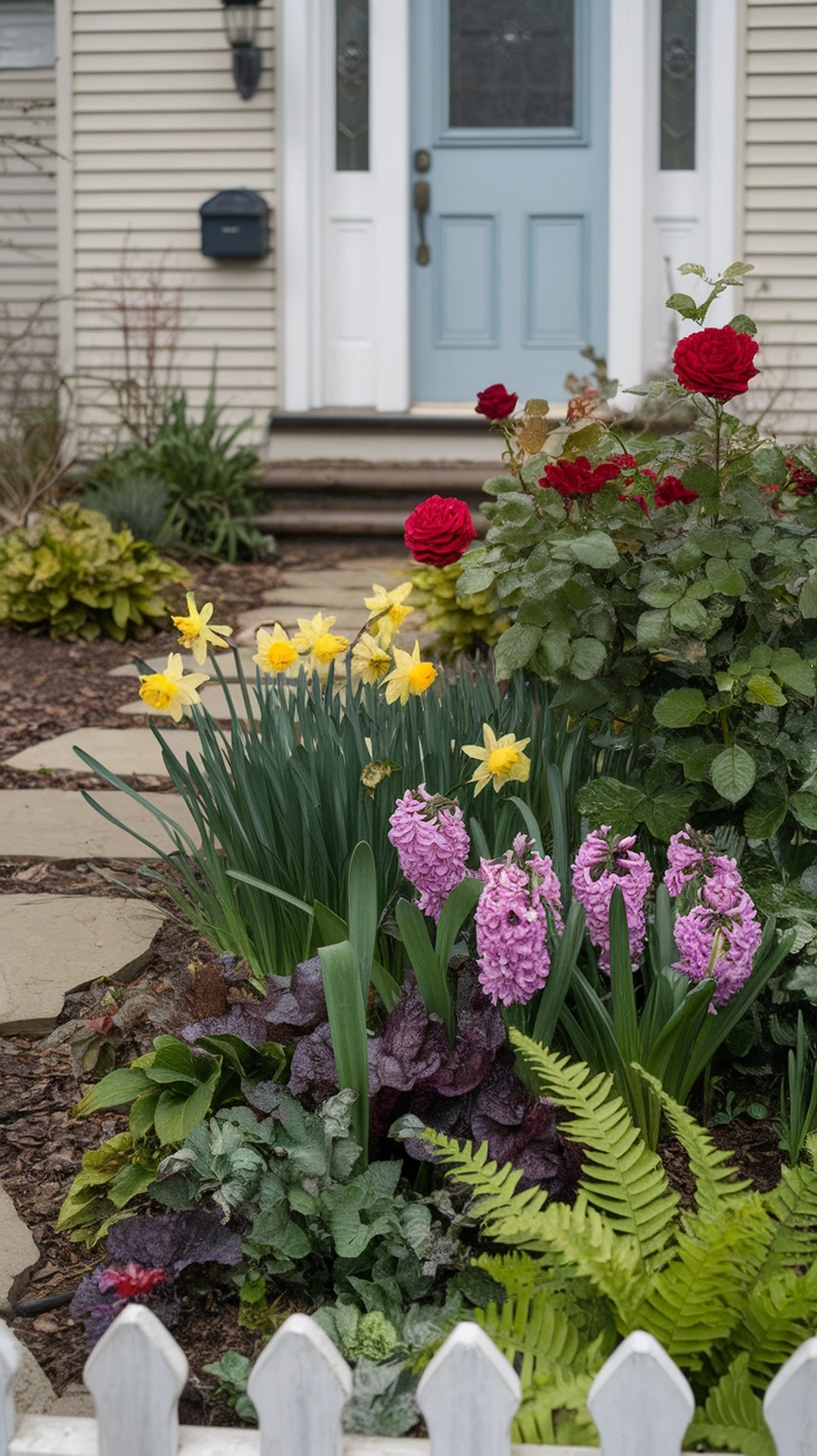
In this article, I’ll show you how to care for your garden all year, from planning to caring for it. You’ll learn to pick plants that match your home and keep your garden interesting all year. You’ll get helpful tips here if you’re new to gardening or want to update your flower bed designs.
I’ve gathered ideas from top landscapers and garden lovers to give you creative solutions for different climates and homes. Ready to start? Let’s see how to make outdoor spaces that will impress your neighbors!
Key Takeaways
- Strategic flower bed placement dramatically enhances curb appeal and property value.
- Consider your home’s architectural style when designing garden spaces
- Choose plants with varying heights, textures, and blooming seasons
- Incorporate both perennials and annuals for year-round visual interest
- Proper planning reduces maintenance needs and water consumption
- Edge your beds clearly to create definition and easier maintenance
Planning Your Front of House Flower Bed
Creating stunning front-of-house flower beds starts with planning. It’s not just about picking plants; it’s about the prep work before you start digging. Let’s review the key steps to make your flower bed project successful.
Assessing Your Space and Light Conditions
Before buying any plants, observe your yard’s conditions. Carry a notebook to track sunlight across your flower bed spots all day.
Does your yard get morning sun and afternoon shade? Or is it sunny all day? Knowing this is key because plants need the right light to grow well.
Also, test your soil type. Is it sandy, clay-heavy, or something in between? Your soil affects how well plants grow.
Remember to note any trees, shrubs, or utility fixtures. These can change how you design your flower beds in front of house. Working with these features makes gardening easier.
Considering Your Home’s Architectural Style
Your flower beds should match your home’s style, not clash with it. I’ve seen plants that didn’t fit with a home’s look.
Try symmetrical flower bed designs with plants like boxwoods and roses for traditional homes. Craftsman homes look great with natural, wild arrangements and native plants.
Modern homes go well with simple, clean flowerbed ideas for the front of the house. Ranch homes are enhanced by horizontal designs that match their look.
When picking plants, take photos of your home’s exterior. This will help you see how the plants look against your home’s colors and materials.
Setting a Realistic Budget and Timeline
Garden dreams can turn into budget nightmares without planning. I always make a detailed budget for plants, soil, mulch, edging, irrigation, and decor.
- Quality soil and amendments
- Mulch for moisture retention and weed control
- Edging materials to define your flower beds in front of the house
- Irrigation supplies if needed
- Decorative elements like rocks or garden art
You don’t have to do everything at once. Start with the basics and add more as you can. This way, you can enjoy your garden without breaking the bank.
Be realistic about your timeline, too. Spring and fall are best for planting new flower beds. This gives plants time to settle before hot weather hits.
Think about how much time you can spend on gardening. If you’re busy, choose easy plants or start small. This way, you can enjoy your garden without too much work.
By planning well, you’ll have a beautiful garden with less stress. It’s all about setting a good foundation for success.
Essential Front of House Flower Bed Ideas
When designing flower beds for your home’s entrance, focus on three key elements. Beautiful front yard flower beds are more than just planting flowers. They show off your home and style. I’ve helped many homeowners turn their yards into stunning gardens.
The best flower bed ideas mix art and practicality. They look great and are easy to care for. Let’s see how to make your front yard flower beds stand out!
Creating Focal Points and Visual Interest
Every garden needs something eye-catching. Focal points make ordinary beds special. They’re the “wow” elements that grab attention.
What makes a great focal point? It could be a flowering shrub or a decorative element. Think about a hydrangea or a unique boulder that shows your style.
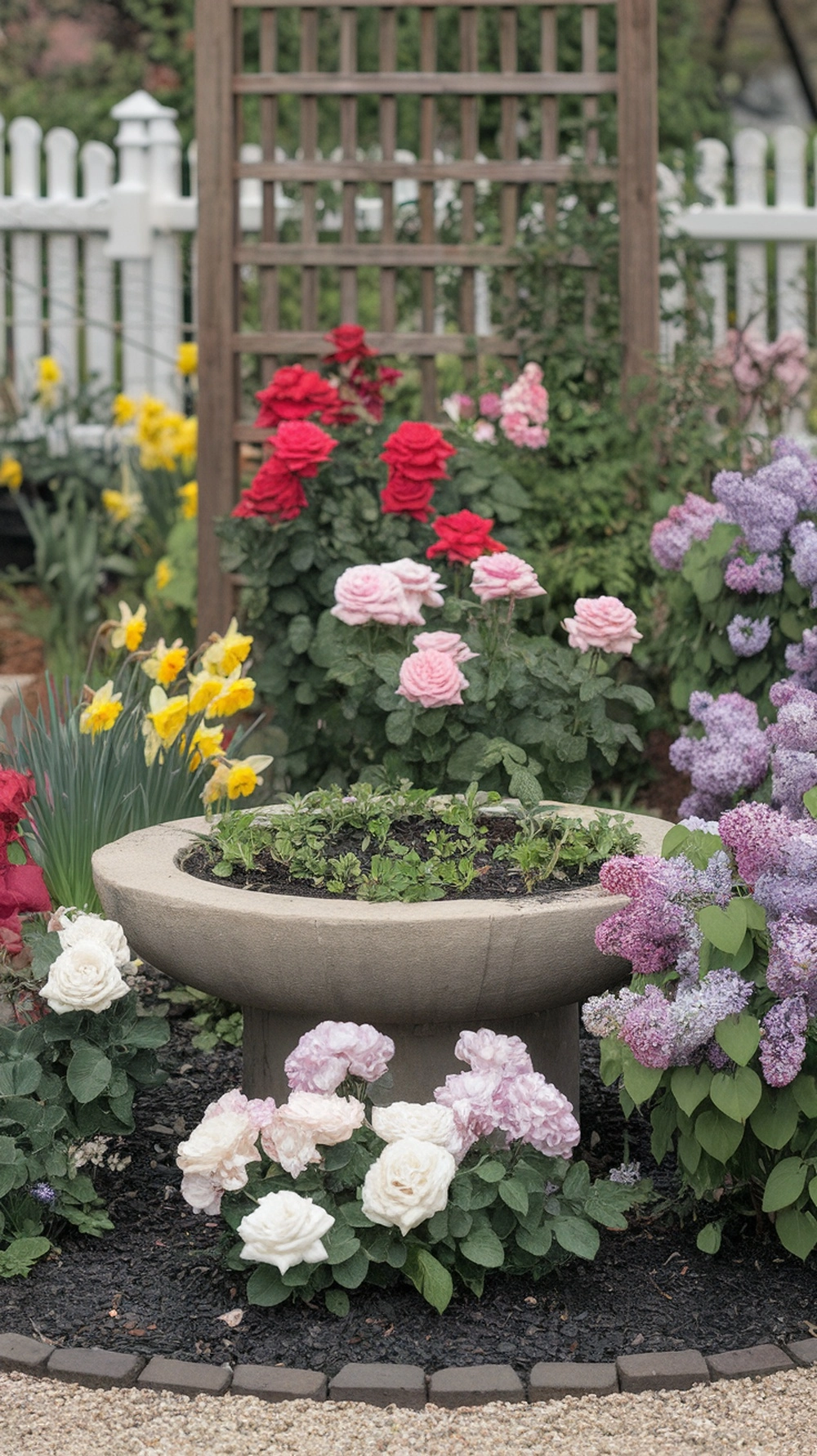
Place your focal point where it draws the eye. Try the end of a pathway or the center of a bed. For big yards, use multiple focal points to guide visitors.
Some great focal point ideas include:
- A dramatic ornamental grass that catches the breeze
- A small flowering tree surrounded by perennials
- A collection of colorful ceramic pots
- A unique garden art piece
Designing with Color Schemes and Seasonal Blooms
Color is key in flower bed design. Think about color like an artist. Do you like bold contrasts or a monochromatic look? Your color choices set the mood of your landscape.
Start with a simple color scheme for beginners. Try these:
- Analogous colors: Use colors next to each other on the color wheel (like purples, blues, and pinks) for harmony
- Complementary colors: Pair opposites on the color wheel (like purple and yellow) for contrast
- Monochromatic: Use different shades of the same color for elegance
For year-round beauty, plan for continuous blooms. Don’t let your beds look empty for months. Choose plants that bloom at different times.
Spring bulbs lead to summer perennials, then fall asters and chrysanthemums. Even winter can be interesting with evergreens and plants with colorful berries. This way, your beds stay beautiful all year.
Incorporating Texture and Height Variation
While flowers are essential, texture and height are the keys to great beds. Even when nothing is blooming, different textures and heights can captivate.
Texture in garden design is about how plants look and feel. Mix different textures for interest. Try ornamental grasses with hostas or yucca plants.
Height variation is also key. Think in layers:
- Background layer: Taller plants (3+ feet) create a backdrop
- Middle layer: Medium-height plants (1-3 feet) fill the bed
- Foreground layer: Short plants and ground covers (under 1 foot) create edges
For beds against your house, put taller plants in the back. For island beds, place taller plants in the center. This guides the eye through your garden.
Remember, plants grow! Don’t plant too close together. Give plants room to grow. Your patience will pay off with a lush, professional look.
Popular Flower Bed Designs Layout Options
Choosing the proper flower bed layout is like picking the perfect frame for a painting. It makes your home’s exterior look complete. The design you select sets the stage for your plants and can significantly improve your curb appeal. Look at popular flower bed layout options to make your front yard stand out!
Curved vs. Straight Edge Designs
You’ll first decide on curved or straight edges when planning your flower beds. Each style gives your landscape a different feel.
Curved flower beds look soft and natural, making your garden feel welcoming. These shapes remind us of nature and add movement to your garden. They’re great for cottage or craftsman-style homes or any place you want to feel more relaxed.
Straight-edged beds, however, have clean lines and a precise look. They match modern homes well. The sharp edges make your garden look planned and sophisticated, even with simple plants.
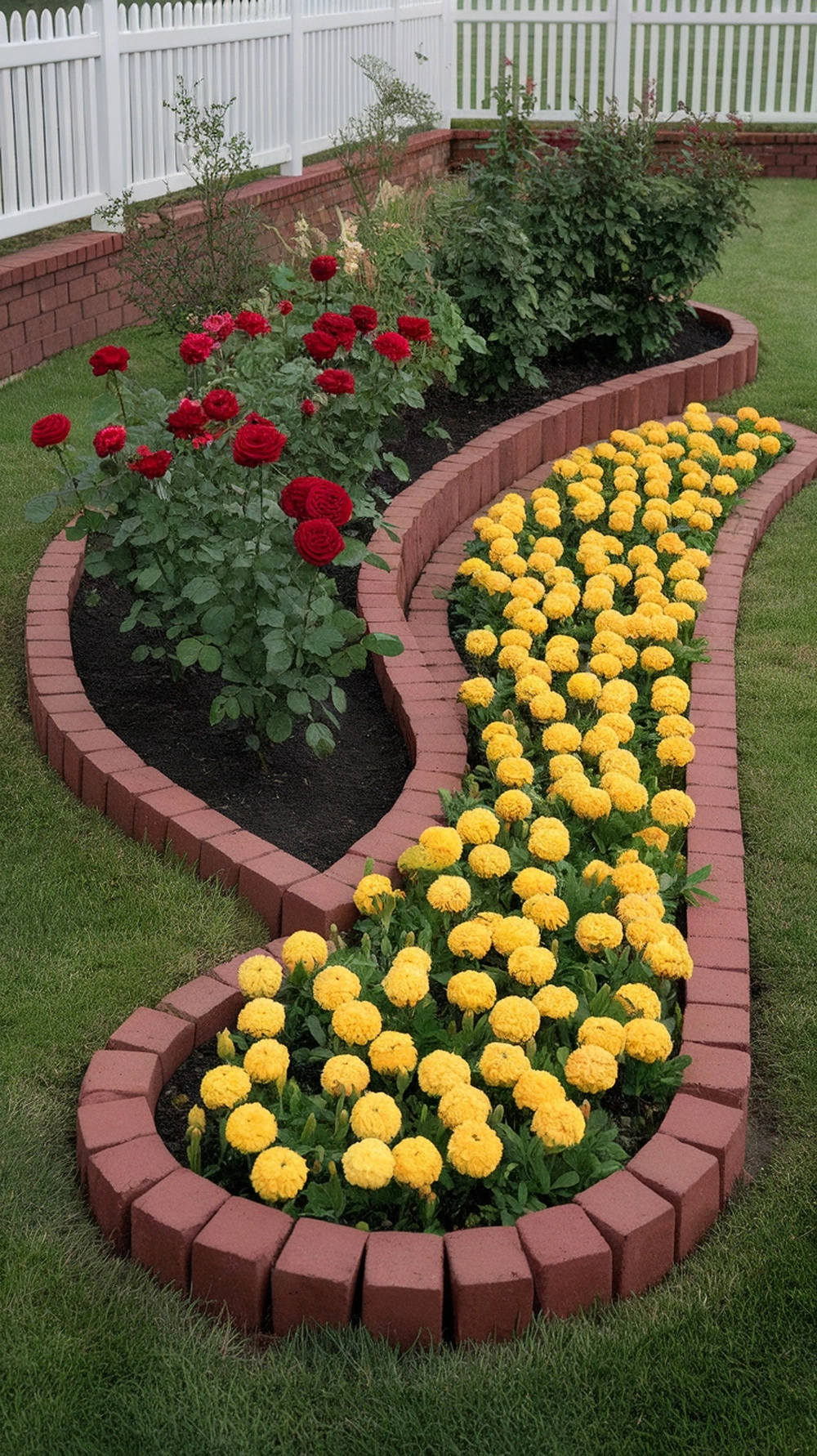
Creating Multi-Level Flower Bed Arrangements
Want to make your front yard more interesting? Multi-level flower bed arrangements are the way to go! They add height and create focal points that catch your eye.
You can use stacked stone, brick, or wood to make levels. Even a slight height difference can change your garden’s look. For homes on slopes, these beds are not just pretty; they help with erosion and water control.
For a multi-level flower bed, put taller plants up high and ground-covering plants at the edges. This creates a waterfall effect that adds depth. I love how these designs change with the light, making shadows and highlights.
Implementing Border and Island Bed Configurations
Border and island beds are two different ways to design your flower beds. Each has its benefits. Many yards use both for the best look!
Border beds go along foundations, walkways, driveways, or property lines. They frame these areas and soften the transition between them. Border beds are great for highlighting your home’s features or creating a path.
On the other hand, island beds are standalone features in your yard. They add interest to open areas, which can be seen from all sides. An island bed near your driveway or in the center of your front yard is a great conversation starter.
Mix border and island beds for a lively landscape. For example, you could have a welcoming border along your walkway leading to a stunning island bed with a tree or seasonal colors.
Simple Flower Bed Ideas for Beginners
If you’re new to gardening, don’t worry! Many simple flower bed ideas can significantly impact without needing to be a pro. Start small and get more confident with these easy ideas.
A simple border along your walkway with 3-5 types of plants creates a professional look. Choose plants that need the same water and light to make care easier. Evergreen shrubs, ornamental grasses, and perennials offer structure and color all year.
Another easy option is a small island bed around a tree or light post. This small space is easy to manage and makes a big difference. To finish it off, add a simple stone or commercial edge.
Remember, even big gardens start small! As you gain confidence, you can expand your flower beds or add more details. The key is to start with a design that fits your skill level and time for upkeep.
Step-by-Step Guide to DIY Flower Beds in Front of the House
Creating your first DIY flower bed is more than just making your home look good. It’s about connecting with your outdoor space. Digging into the soil and creating something beautiful is incredibly satisfying.
It greets you every time you come home. If you want to make your front yard beautiful with DIY flower beds, this guide will walk you through every step!
Marking and Preparing the Area
The first step is to mark and prepare your space. Start by outlining the bed with a garden hose or rope. This lets you adjust the shape until it looks perfect from all angles.
After you’re happy with the shape, remove the grass or plants. A shovel works well for small areas. For bigger areas or if you have back problems, try the no-dig method. This method takes longer but is easier on your body!
Pro tip: Take photos of your bed from your home’s entry points and windows before digging. This ensures the shape looks good from where you’ll see it most.
Installing Edging and Borders
Good edging makes your DIY flower beds look professional. It keeps grass out and makes your beds look neat. The material you choose affects how long your beds will last.
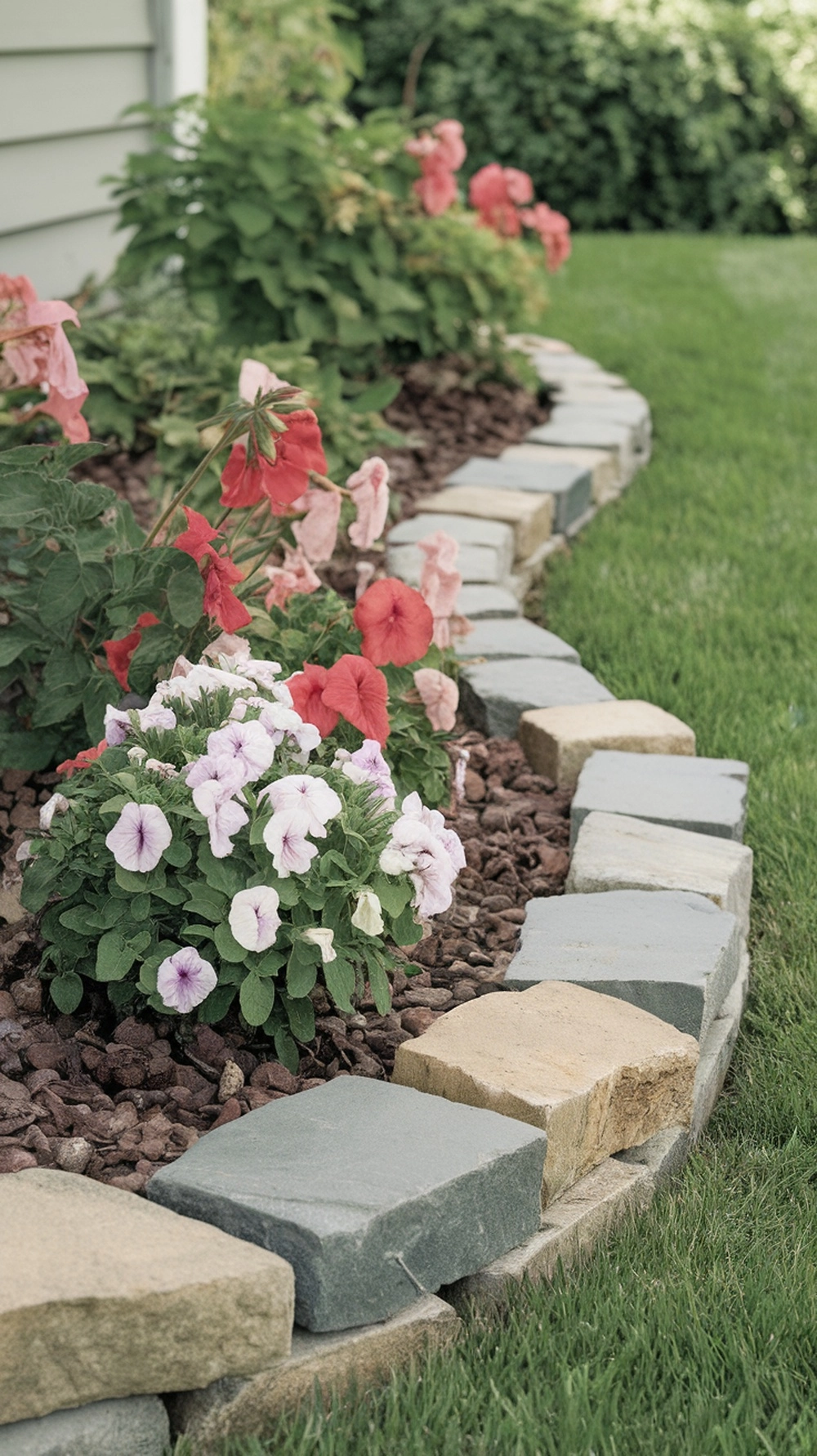
You can try different edging materials. Plastic is cheap and easy to use, while metal is durable and sleek. Stone, brick, or concrete pavers work well for a natural look. Choose based on your home’s style and what you like.
Soil Preparation and Amendment Techniques
Soil preparation is key to the success of your DIY flower beds. It’s like building your home’s foundation—everything depends on it!
Start with a soil test from your local extension office. This tells you what your soil needs. Most soils benefit from compost, which improves drainage and water retention.
Add 2-3 inches of compost to the top 6-8 inches of soil for my flower beds. If your soil test shows deficiencies, now is the time to fix them with the right amendments:
- For acidic soil lovers like azaleas, add pine bark or peat moss
- For alkaline soil lovers like clematis, add limestone
- For heavy clay, add gypsum and compost
- For sandy soil: add compost and coconut coir
Planting Methods for Lasting Impact
Now it’s time to make your DIY flower bed come alive with plants! Choose plants that look good now and will grow well together. Don’t plant too close together to avoid overcrowding.
Space plants based on their mature size. This might look sparse initially, but it is better in the long run—group plants with similar needs together for easier care.
Arrange plants in pots before planting. This lets you see how they look from different angles and make changes. Pay attention to how the bed looks from your most common views.
When you’re happy with the arrangement, it’s time to plant! Dig holes twice as wide as the root ball but only as deep. This helps roots spread out. Water deeply and add mulch, keeping it away from stems and trunks. My favorite planting technique is to mix compost with native soil in each hole. This gives each plant a perfect growing spot while it establishes roots.
Creating DIY flower beds is very rewarding. There’s nothing like admiring the beauty you’ve made. Watching them grow and change season after season is even better. A weekend project can bring years of joy!
Low-Maintenance Flower Beds in Front of the House
Creating stunning flower beds in front of your house can be easy and beautiful. You don’t have to spend all your weekends gardening. With thoughtful planning, you can have gorgeous front-yard flower beds that care for themselves.
Selecting Drought-Tolerant and Native Plants
Choosing the right plants is key to a low-maintenance garden. Native plants are perfect because they grow well in your area. They adapt to your local weather and soil.
Native perennials like coneflowers and yarrow are great. They add color and need little care. Ornamental grasses also add beauty and need almost no work.
Drought-tolerant plants are also suitable for low-maintenance flower beds in front of the house. Lavender and sedum need little water to add interesting colors to your garden.
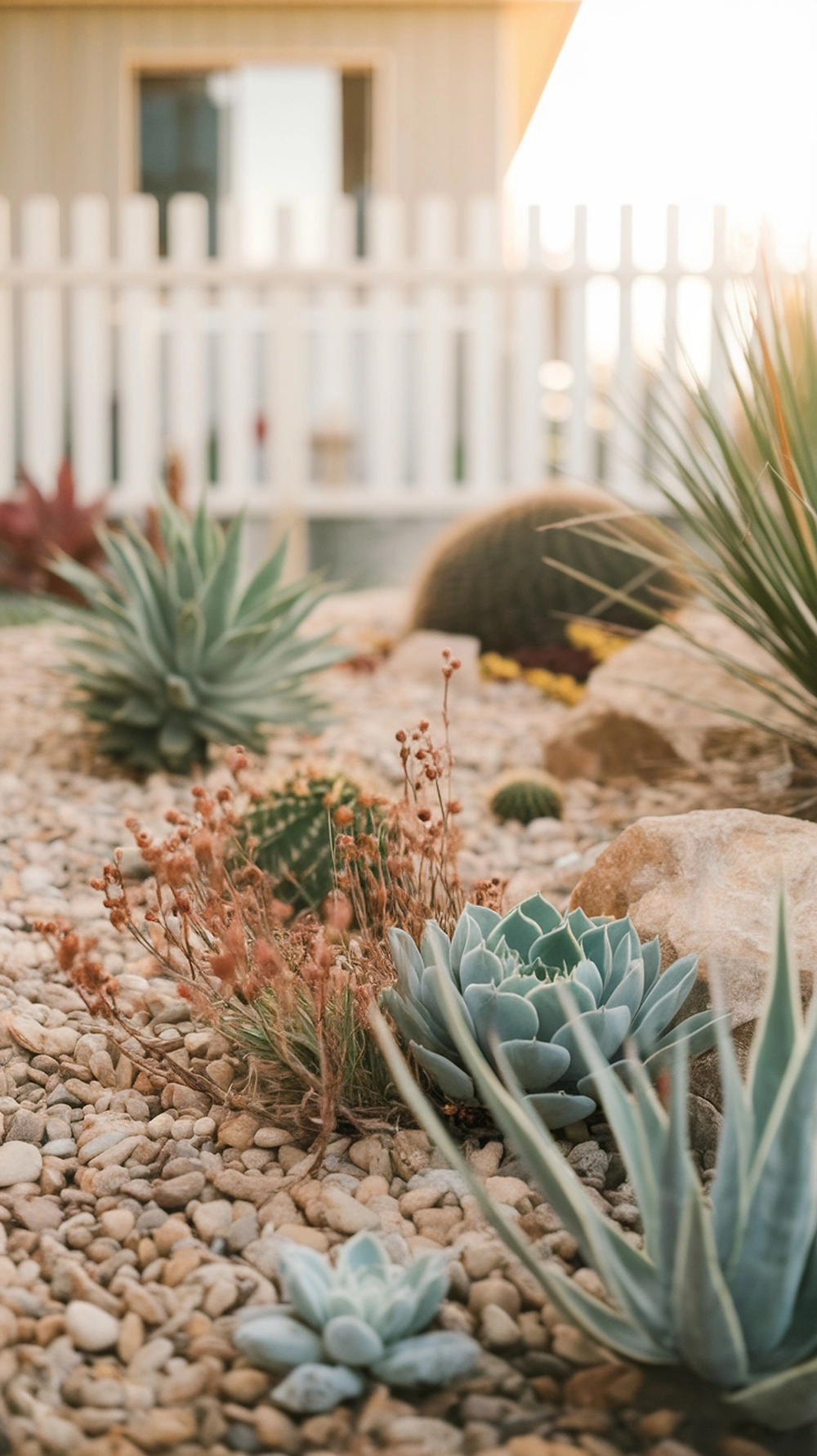
Implementing Time-Saving Design Strategies
How you arrange your plants can save you time. Planting in groups makes your garden look bold and is easier to care for.
Stick to a few types of plants in your simple flower beds in front of the house. This will make your garden look good and easier to care for, and it will also help you know what each plant needs.
Use fewer annual flowers. They add color but need to be replanted every year. Focus on perennials and shrubs that come back every year.
Effective Mulching and Weed Prevention
Mulching is a secret to easy gardening. A 2-3 inch layer of mulch keeps weeds away and saves water. It also improves the soil as it breaks down.
Use organic mulches like bark or leaf compost. They look good and improve the soil. For tough weeds, use landscape fabric under the mulch.
Good edging is also essential. It keeps grass out of your garden. Use metal, stone, or plastic edging to save time and effort.
With these tips, you can have beautiful, low-maintenance flower beds in front of your house. They make your home look great without needing constant care. The trick is to work with nature and choose plants that thrive in your area.
Inexpensive Flower Bed Ideas That Make an Impact
Make your front yard beautiful without spending a lot. I’ve found ways to make your yard look great without breaking the bank. With creativity, your yard can impress everyone while staying affordable.
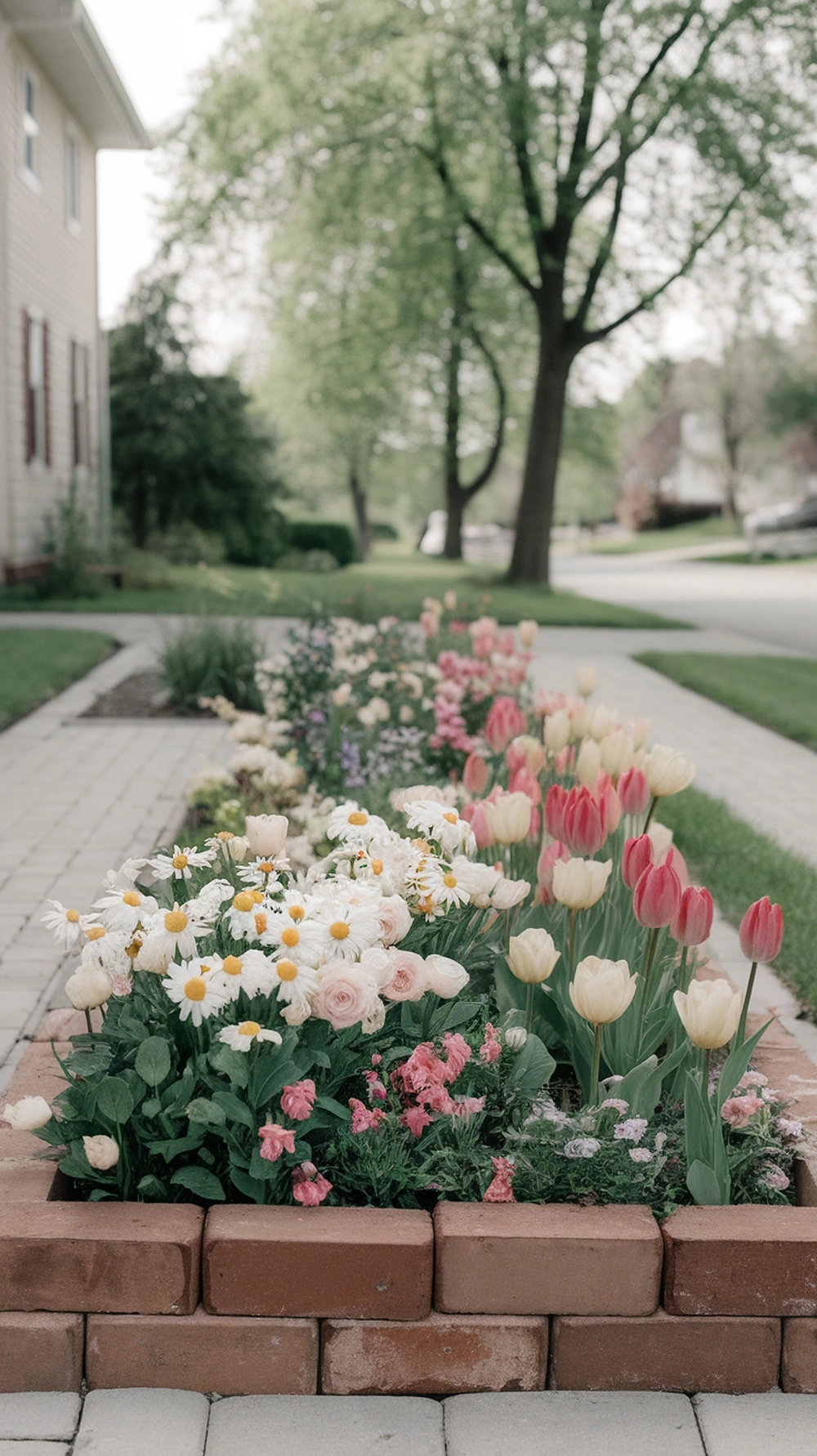
Budget-Friendly Plant Choices and Sources
Start with small plants to save money. They grow fast and are cheaper than big plants. I bought 4-inch perennials that grew big in just two years.
Look for end-of-season sales at garden stores. These sales offer great deals on healthy plants and can help you start your garden cheaply.
Join a local gardening club for free plants. They often have plant swaps. I got new plants without spending money. Online groups and forums are also suitable for finding plants.
Seeds are another way to save. A packet of seeds costs as much as one plant but gives many flowers. Some plants even grow back every year.
Creating DIY Decorative Elements
Paint terracotta pots in colors that match your house to make your garden unique without spending a lot. I painted mine copper and turquoise, and they look amazing.
Make your stepping stones. Mix concrete, add colors, and press in decorations. Each stone is cheap but looks custom.
Use natural things for decoration. Collect branches for trellises or stakes. I made an archway with branches, and people think it’s expensive.
Repurposing and Upcycling in Flower Beds
Find new uses for old things. Old wheelbarrows and boots can be planters. I turned an old colander into a succulent planter.
Use old materials for edging. Brick, stone, or bottles can make borders. Look for leftovers at construction sites or stone yards.
Give old furniture a new life. An old ladder can display plants. I fixed a broken chair with plants, and it’s now a hit.
Dividing Perennials to Expand Your Garden
Divide plants to grow your garden. This saves money and makes plants healthier. Many perennials need dividing every few years.
Hostas, daylilies, and grasses are easy to divide. They bloom quickly after planting.
Divide in spring or fall. Dig up the plant, separate the roots, and replant. Water the well and they’ll grow strong.
Creating a beautiful yard doesn’t need to cost a lot. My DIY flower bed ideas get more compliments than fancy gardens. It’s rewarding to make something beautiful on a budget.
Creative Accents for Front Yard Flower Beds Against the House
The narrow strip between your house and lawn is perfect for creative accents. These plantings frame your home and make a great first impression. Adding the correct decorative elements can make your front yard flower beds look amazing against the house.
Incorporating River Rock and Decorative Stone
Stone elements add texture and interest throughout the year. River rock flower beds in front of the house are practical and beautiful. They can also form dry creek beds that manage rainwater and look natural.
Decorative stones are a good choice instead of mulch. They don’t wash away and don’t need to be replaced every year, making them a wise choice for your garden.
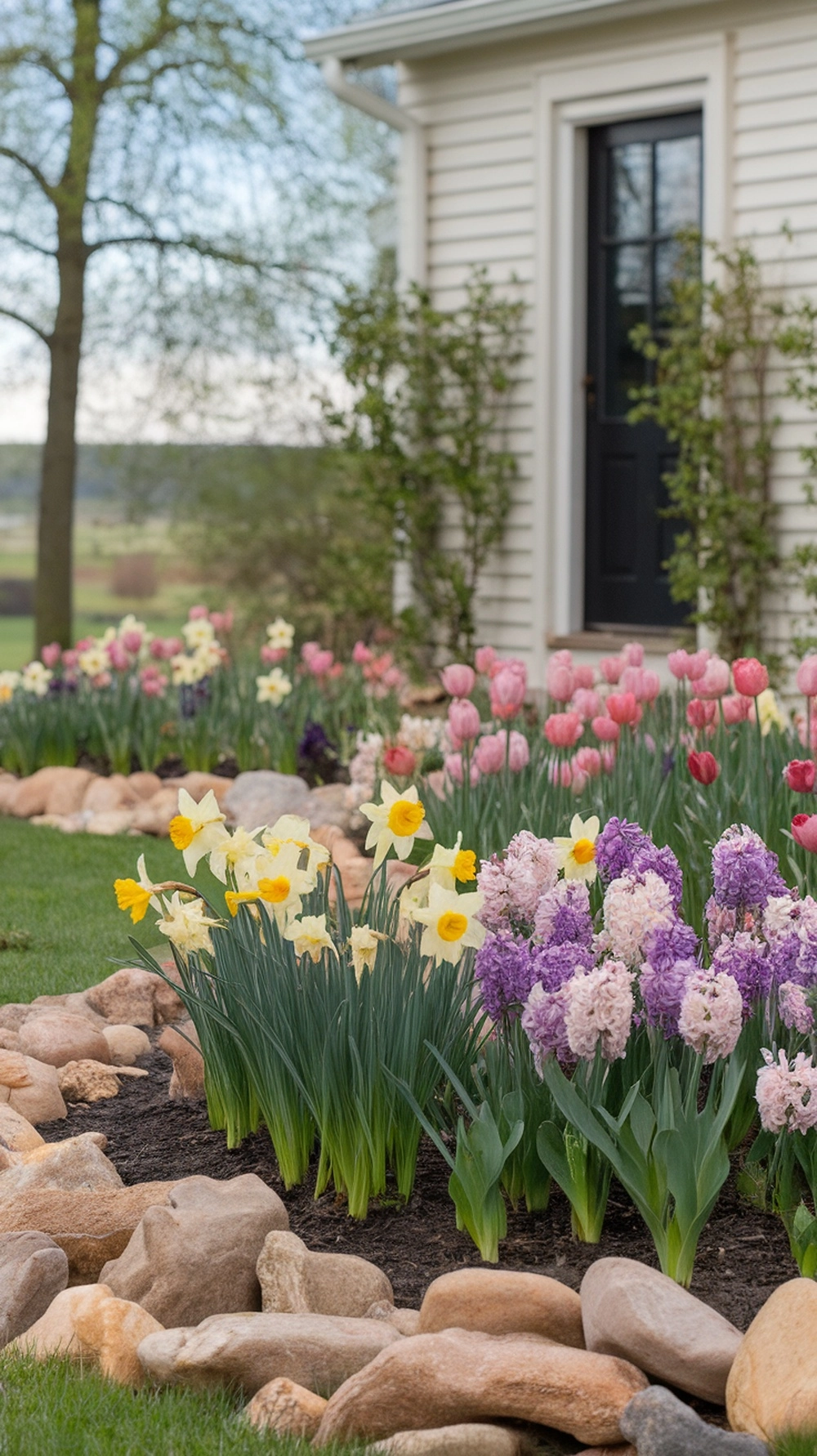
Use large stones as focal points in your beds. They add structure and interest, even in winter. Choose stones that match your home’s colors and materials for a cohesive look.
Using Potted Plants Within Flower Beds
Adding containers to your beds is a great idea. Potted flower beds in front yards are flexible and can change with the seasons. You can swap out plants to keep your garden looking fresh.
Containers are great for plants that need special soil. Put that azalea in a pot with acidic soil and place it in your garden.
Vary the sizes and styles of your containers for more interest. Tall pots add height, while wide bowls ground your garden. Matching containers can add elegance to formal landscapes.
Adding Garden Art and Ornaments
Garden art adds personality to your landscape, tells your story, and makes your garden memorable. Choose pieces that mean something to you, not just because they’re trendy.
Consider birdbaths for wildlife and a traditional touch. Metal sculptures add modern flair. Glass gazing balls reflect light and plants, creating magic.
Be careful not to overdo it with ornaments in front-yard flower beds against the house. A few special pieces can make a bigger impact than many small ones.
Lighting Options to Highlight Your Design
Lighting makes your garden beautiful at night. Solar path lights are easy to install and eco-friendly. They create a welcoming glow.
Uplighting highlights architectural plants and trees at night, turning them into sculptures. This is a great way to make your garden stand out after dark.
For holidays, add string lights to your garden. They create a magical atmosphere, and you can enjoy your garden’s beauty day and night.
With these accents, your flower beds become a part of your home’s style. Natural elements, containers, art, and lighting create a beautiful, changing look.
Seasonal Maintenance for Flower Beds Front Yard
Stunning front yard flower beds need more than just design. They need regular care to stay beautiful all year. Let’s see how to keep your flower beds looking great through every season!
Spring and Summer Care Routines
I clean my flower beds when spring comes, removing winter debris and dead leaves. It’s like giving your garden a fresh start!
Then, I cut back dried foliage from perennials. This is the perfect time to apply a slow-release fertilizer. Your plants will bloom more!
Refreshing your mulch in spring is essential. It keeps weeds away and retains moisture. I use a 2-3 inch layer, avoiding plant stems.
Summer heat means more watering. Deep, infrequent watering helps roots grow strong. Water in the early morning to prevent disease.
Don’t forget to deadhead! It keeps your beds tidy and encourages more blooms. I walk through my garden often with pruners.
Fall Preparation and Winter Protection
Fall is busy in front-yard flower beds. I divide overcrowded perennials and plant bulbs for spring. This gives me free plants and early color.
Some perennials keep their seed heads for winter interest, while coneflowers and black-eyed Susans add structure. Ornamental grasses do the same.
Before the first freeze, I add more mulch. In colder areas, additional protection is needed. I wrap burlap around shrubs and use rose collars.
Remember to clean and store your garden tools. A light coating of oil prevents rust, making them ready for spring.
Troubleshooting Common Flower Bed Problems
Even well-maintained flower beds face challenges. Yellow leaves might mean too little water or nutrients; too much water can cause wilting and yellowing.
For holes in leaves, look for slugs, Japanese beetles, or caterpillars. Use beer traps for slugs and the least toxic solutions for others.
Brown leaf edges might indicate sunburn or fertilizer burn. To treat sunburned plants, flush excess nutrients with water and provide shade.
Regular observation is key in gardening. Walking through your garden often helps catch problems early. Keep a garden journal for future reference.
Even experienced gardeners face challenges. Each season brings new learning. The joy of gardening is in the ongoing care and relationship with our plants.
Conclusion
We’ve looked at many flower bed ideas in this guide. You now know how to make beautiful flower beds in front of your house. This includes planning, design, maintenance, and budget-friendly options.
The best flower bed ideas aren’t always the most complicated or pricey. The key is choosing plants that match your style and your living conditions.
If you’re new to gardening, start small. A simple flower bed by your front walkway can dramatically change the look of your home. As you gain confidence, you can grow your garden and try new designs.
Gardens change with the seasons, which is why they are so rewarding. You’ll see new growth, fresh flowers, and chances to change your design each year.
What flower bed idea are you most excited to try? Will you go for bright colors or soft pastels? The choice is yours!
I hope this guide has inspired you to improve your front yard. Your dream flower bed is waiting for you. It will welcome you home every day with beauty and joy. Happy gardening!
